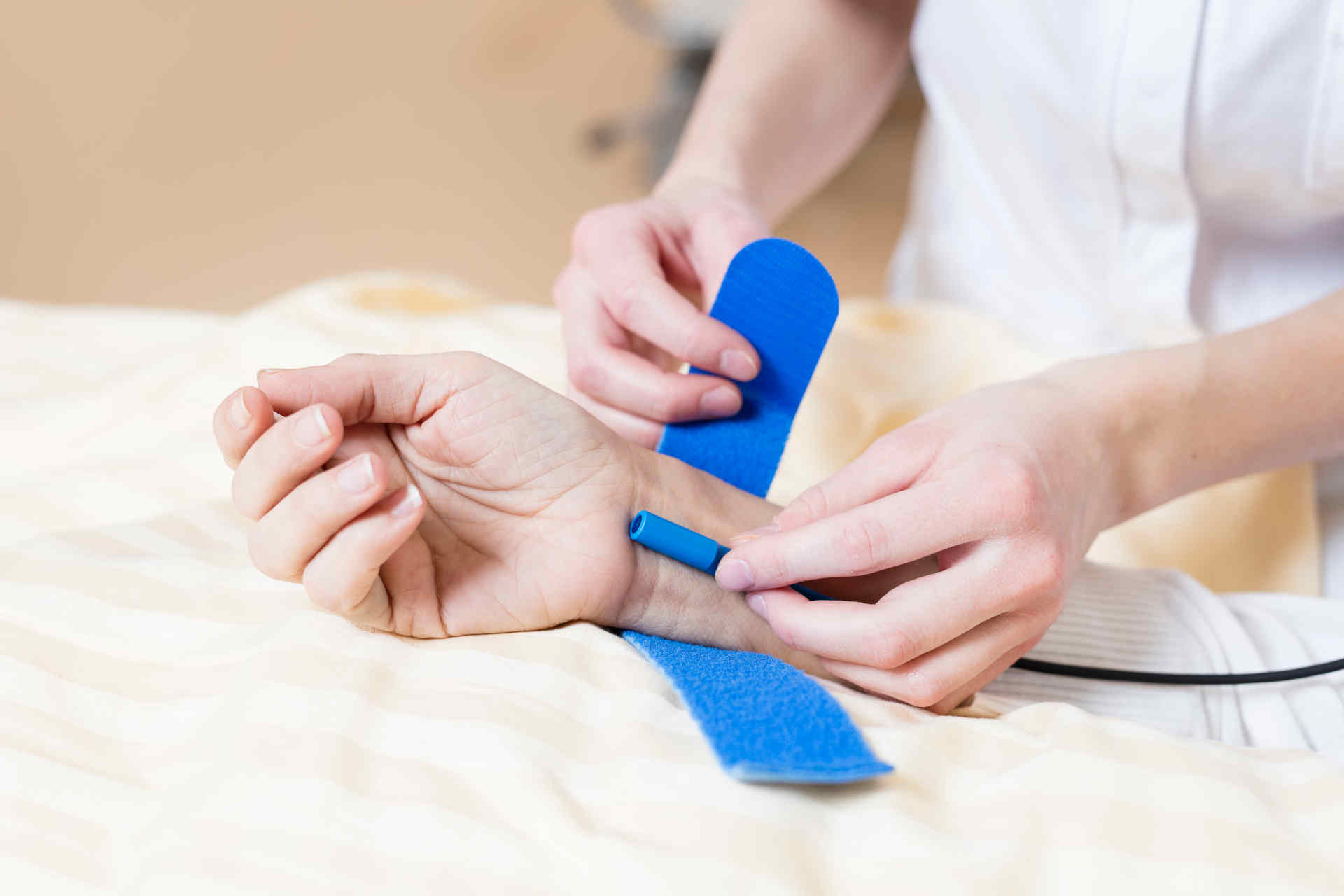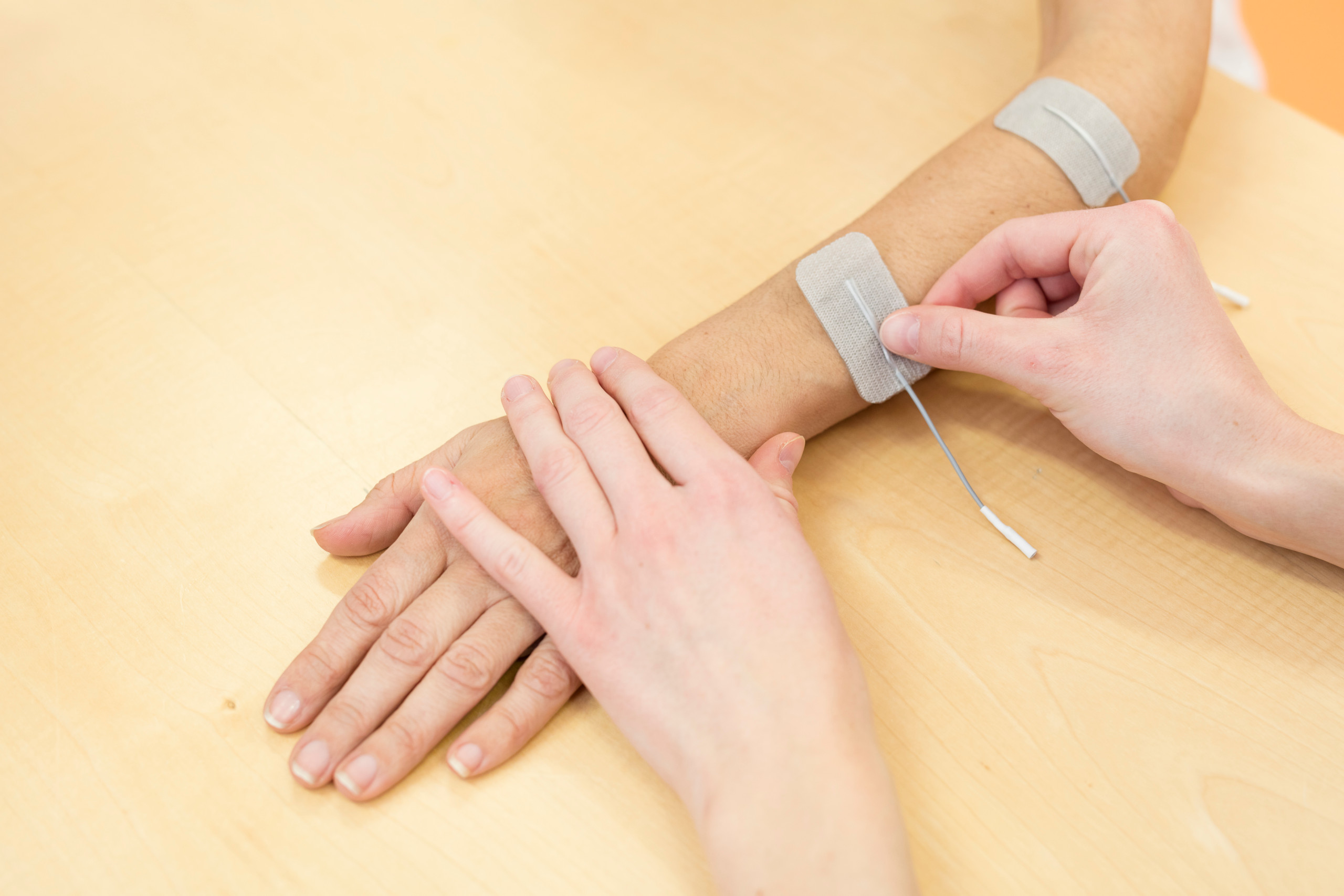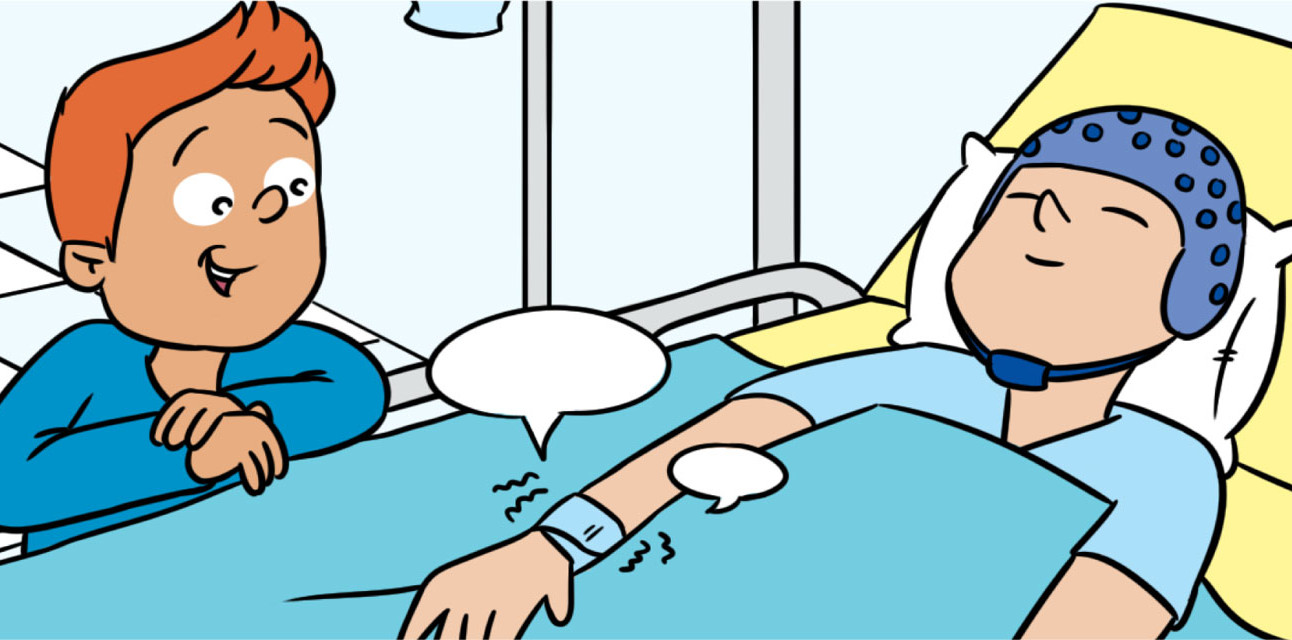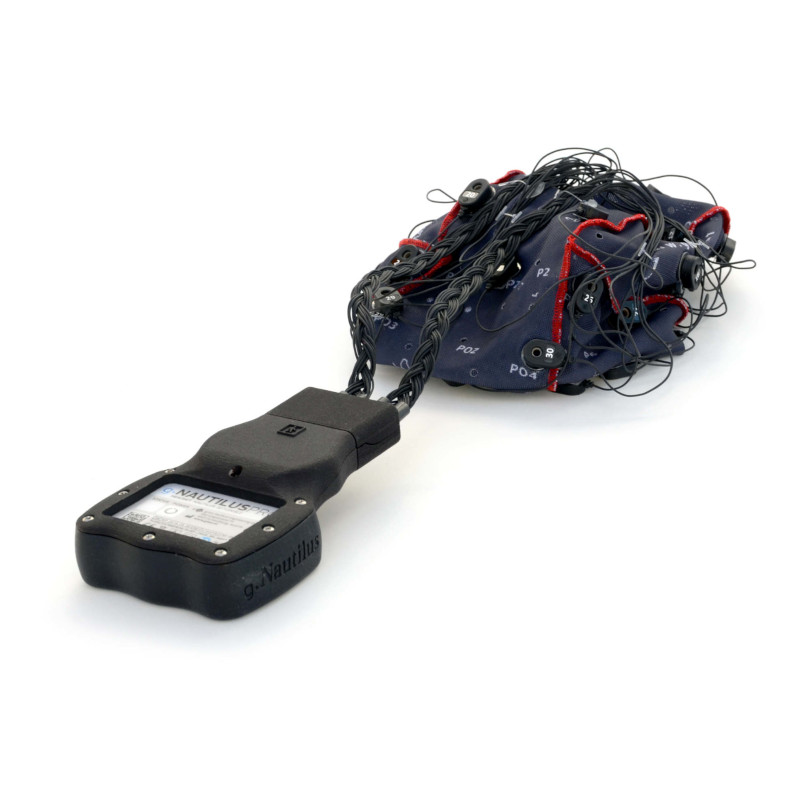
LEARN ABOUT PATIENTS' MENTAL STATE
mindBEAGLE uses Brain-Computer Interface (BCI) technology for quick and easy assessment of DOC and LIS patients and even provides basic communication with some of them. It is used to determine whether patients can understand and follow basic task instructions, even though they are diagnosed as people in a vegetative state (VS, also called UWS or Unresponsive Wakefulness Syndrome), minimally conscious state (MCS) or (completely) locked-in state (LIS/CLIS).
The lack of feedback is a huge barrier to medical diagnosis or clarifying the patient’s condition. mindBEAGLE gives physicians, family members or caregivers a broader knowledge of the patient’s perception and consciousness. In the assessment phase, mindBEAGLE will provide reliable information about the command following abilities of a patient. The system also supports a longitudinal screening to investigate stability and improvement of responses or daily changes in awareness. Many of these patients have fluctuations of the command following ability which can be detected with the mindBEAGLE system.
Another big problem is the prediction of the outcome of DOC patients for family members and physicians. With the mindBEAGLE classification accuracy we can predict if a patient will get better very accurately.
Usually, DOC patients lack of proper training options that can be applied in a systematic way. mindBEAGLE includes 2 functional electrical stimulation channels to train upper and lower limb muscles and to reduce spasticity. Additionally, mindBEAGLE comes with 2 transcranial electrical stimulation channels to electrical stimulate the brain.
| Assess command following abilities in DOC/LIS patients |
| Detect fluctuations in command following |
| Allow patients to answer YES/NO questions |
| Predict the outcome and possible improvements of patients |
| Train the patient with the vibro-tactile stimulation protocol |
| Train the patient with the motor imagery protocol |
| Perform brain stimulation with transcranial electrical stimulation |
| Perform muscle re-education with functional electrical stimulation |
| Acquire resting state EEG |
| AEP | Ultra-precise stereo stimulation |
| Vibro-tactile EPs | Vibro-tactile stimulation of up to 7 body parts |
| Motor imagery | Motor movement imagination |
| Raw data | Resting-state analysis |
| FES | 2 channels for muscle re-education |
| TES | 2 channel transcranial electrical brain stimulation |
| EEG headset | 16 channels g.Nautilus PRO flexible with 24 Bit resolution |
AUDITORY EVOKED POTENTIALS
The AEP paradigm is the first one used for testing the cognitive functions of the patients. First of all it shows that the patient is able to hear the instructions and it shows that the patient is able to distinguish low and high tones. This does not show yet that the patient has command following, because the AEP could be produced just by passive listening.
VIBRO-TACTILE EVOKED POTENTIALS
The VEP paradigm allows to test command following in an objective way. We are placing one vibrator on the left hand, one vibrator on the right hand and a couple of vibrators on other positions. Then the system is instructed to patient to count left or right. If the analysis shows a high accuracy we have objectively shown that the patient was able to do the tasks correctly and this proofs command follwoing. In a next setp the VEP principle can be used to answer YES/NO questions. mindBEAGLE offers a training protocol with the VEP paradigm, too.
MOTOR IMAGERY
The motor imagery protocol instructs the patient to imagine left or right hand movement imagination for 8 minutes. This is a standard procedure in physio-therapy and can be used as a training for the patient. Beside that the motor imagery paradigm can be used to answer YES/NO questions or to perform a brain assessment for command following.
BRAIN ASSESSMENT OF COMMAND FOLLOWING
mindBEAGLE uses auditory and vibrotactile stimulation in order to assess a patient’s condition. The auditory awareness is tested by playing sounds with high and low frequencies to the patient. To test the tactile awareness, the patient feels vibrations on the hands, legs and other body parts. During these stimulations, the patient is asked to focus on certain sounds and vibrations. A special EEG-cap measures the brain activity during this procedure. If patients are able to perceive auditory and tactile stimuli, mindBEAGLE will be able to find a statistical relevant brain response and applies machine learning techniques to find the target brain response.
This results in a visualization of the brain response and an accuracy ranging from 0 to 100 %. If the accuracy is high it means that the patient is able to follow the tasks and this means the person has command following. If the accuracy is low the patient is not able to do the task correctly and it means that the patient does not have command following.
DETECTION OF FLUCTUATIONS IN COMMAND FOLLOWING
mindBEAGLE is testing command following with auditory, vibrotactile stimulation and motor imagery protocols. The system is instructing the patient to do certain tasks while the high-quality EEG data is recorded. Each task last between 2.5 – 8 min and collects systematically EEG data. Then the BCI system calculated the accuracy ranging from 0 to 100 % and it is a measure if the patient can do the task correctly.
These accuracy values can be always high, always low or they can fluctuate from one session to another one and can be effectively used to quickly understand if the patient has command following on a certain day. Furthermore, the accuracies can be used as a trending tool for the patient.
ANSWER YES/NO QUESTIONS
mindBEAGLE allows a patient to answer YES/NO questions that the operator is asking him. This is done with vibro-tactile stimulations of different body parts and the patent can say YES when he attends to the left hand vibrations and the patient can say NO by attending to left hand stimulations. Normally we are asking 10 known questions and if most of them are correctly answered it is a very objective proof that the patient has command following.
Beside the vibro-tactile stimulation it is possible to use left and right hand movement imaginations to answer the questions. mindBEAGLE only outputs a YES or NO if the machine learning algorithms detects that the answer is certain otherwise the system rejects the answer.

PREDICTION OF OUTCOME
mindBEAGLE is running systematically standardized brain assessment protocols. During these protocols the high-quality EEG data is recorded and analyzed with sophisticated algorithms and machine learning techniques resulting in a classification accuracy. In clinical studies we could show that high accuracies are predicting an improvement of the patient in terms of coma-recovery scale-revised (CRS-r).
This means that with an initial assessment with the auditory or vibro-tactile simulation we can already predict a positive outcome for the patient. This is of course essential information for the family and physician.

TRAIN THE PATIENT WITH THE VIBRO-TACTILE STIMULATION PROTOCOL
mindBEAGLE includes a vibro-tactile stimulation protocol that leads to improvements in CRS-r. The patient is instructed via the system to count the vibro-tactile stimulations of the left and right hand which produces an activation of the sensori-motor cortex. The protocol should be repeated for 30 min on 10 consecutive days.

TRAIN THE PATIENT WITH MOTOR IMAGERY PROTOCOL
Motor imagery is a standard therapy used in physio-therapy. mindBEAGLE includes a motor imagery protocol that instructs the patient via the loudspeaker to imagine left or right hand movements. At the same time the limbs are stimulated with vibrations to increase the activation of the sensorimotor cortex. The paradigm is running for 8 minutes.

PERFORM MUSCLE RE-EDUCATION WITH FUNCTIONAL ELECTRICAL STIMULATION
mindBEAGLE comes with 2 FES stimulation channels that can be mounted on upper or lower limbs. The stimulation protocol is running for a given time and leads to muscle re-education and a reduction of spasticity.

MINDBEAGLE COMMUNICATION EXPLAINED FOR YOUNG MINDS
People with complete locked-in syndrome can’t speak, move their hands, or even choose to blink or move their eyes, but the brain is working. Read this article in Frontiers for Young Minds to learn about the communciation paradigm of mindBEAGLE.

BRAIN STIMULATION WITH TRANSCRANIAL ELECTRICAL STIMULATION
mindBEAGLE comes with 2 bipolar tDCS stimulation channels that can be used to electrically stimulate the brain with DC currents. In studies it was shown that a pre-frontal stimulation leads to improvements of the CRS-r in DOC patients.
ACQUIRE RESTING-STATE EEG
mindBEAGLE allows to acquire resting-state EEG which can be read into the g.BSanalyze off-line analysis package for gaining more in sights about the status of the brain.
COMMUNICATION WITH DOC, LIS, COMA PATIENTS
In this video the therapist asks a DOC patient if she is speaking in Italian language. The expected answer is YES. The patient can say YES, by counting little vibrations given to the left hand and can say NO, by counting little vibrations given to the right hand. At the end of the video you can see, that the patient gives the correct answer. Mostly we are asking 5-10 questions and if the patient answers most of them correctly, we get an objective proof of command following.

mindBEAGLE combines important electro-physiological tests that allow us to search for signs of consciousness after coma. The big advantage of mB is that it is integrated. You can take it to any patients and plug them in and get the results directly. It is still a challenge and it doesn’t work with all the patients. mindBEAGLE is a big help for us to use the paradigms as they are implemented in mB for very challenging patients.
Dr. Steven Laureys, Neurologist - FNRS Research Director, Coma Science Group, GIGA-Ulg and CHU Liège, BelgiumFREQUENTLY ASKED QUESTIONS
Murovec, N., Heilinger, A., Xu, R., Ortner, R., Spataro, R., La Bella, V., Miao, Y., Jin, J., Chatelle, C., Laureys, S. and Allison, B.Z., 2020. Effects of a Vibro-Tactile P300 based Brain-Computer Interface on the Coma Recovery Scale-Revised in Patients with Disorders of Consciousness. Frontiers in Neuroscience, 14, p.294.
Annen, Jitka, Séverine Blandiaux, Nicolas Lejeune, Mohamed Ali Bahri, Aurore Thibaut, Woosang Cho, Christoph Guger, Camille Chatelle, and Steven Laureys. “BCI performance and brain metabolism profile in severely brain-injured patients without response to command at bedside.” Frontiers in Neuroscience 12 (2018): 370.
Spataro, R., Heilinger, A., Allison, B., De Cicco, D., Marchese, S., Gregoretti, C., La Bella, V. and Guger, C., 2018. Preserved somatosensory discrimination predicts consciousness recovery in unresponsive wakefulness syndrome. Clinical Neurophysiology.
Ortner, R., Allison, B.Z., Pichler, G., Heilinger, A., Sabathiel, N. and Guger, C., 2017. Assessment and Communication for People with Disorders of Consciousness. Journal of visualized experiments: JoVE, (126).
Guger, C., Allison, B., Kammerhofer, A., Guttmann, F., Tim, J.V., Spataro, R., La Bella, V., Annen, J., Laureys, S., Heilinger, A. and Ortner, R., mindBEAGLE – a new system for the assessment and communication with patients with disorders of consciousness and complete locked-in syndrom. 2017 IEEE International Conference on Systems, Man and Cybernetics (SMC), 3008-3013.
Ortner R., Spataro R., Scharinger J., Allison B.Z., Guger C. (2017). Vibro-Tactile Evoked Potentials for BCI Communication of People with Disorders of Consciousness and Locked-in Syndrome. Proceedings of the 7th Graz Brain-Computer Interface Conference 2017, 379-382.
Huggins, J. E., Guger, C., Ziat, M., Zander, T. O., Taylor, D., Tangermann, M., … & Ruffini, G. (2017). Workshops of the Sixth International Brain–Computer Interface Meeting: brain–computer interfaces past, present, and future. Brain-Computer Interfaces, 1-34.
Guger, C., Spataro, R., Allison, B. Z., Heilinger, A., Ortner, R., Cho, W., & La Bella, V. (2017). Complete Locked-in and Locked-in patients: Command following assessment and communication with vibro-tactile P300 and motor imagery brain-computer interface tools. Frontiers in Neuroscience, 11, 251.
Ortner, R., Annen, J., von Oertzen, T., Espinosa, A., Rodriguez, J., Allison, B. Z., Edlinger, G., Laureys, S., Hamberger, M., Kammerhofer, A., Guttmann, F., Guger, C. (2016) BCIs for DOC Patients: Assessment, Communication, and New Directions. In International Conference on Universal Access in Human-Computer Interaction (pp. 62-71). Springer International Publishing.
Annen, J., Ortner, R., Wannez, S., Piarulli, A., Allison, B. Z., Guger, C., & Laureys, S.: mindBEAGLE: An EEG-based BCI developed for patients with disorders of consciousness. Conference Paper: International Brain-Computer Interface (BCI) Meeting 2016
Lugo ZR, Quitadamo L, Bianchi L, Pellas F, Veser S, Lesenfants D, Real RG, Herbert C, Guger C, Kotchoubey B, Mattia D, Laureys S, Kübler A and Noirhomme Q (2016). Cognitive processing in non-communicative patients: what can event-related potentials tell us? Frontiers Hum. Neurosci.
Gibson, R.M., Chennu, S., Fernández‐Espejo, D., Naci, L., Owen, A.M. and Cruse, D., 2016. Somatosensory attention identifies both overt and covert awareness in disorders of consciousness. Annals of neurology, 80(3), pp. 412-423.
C. Guger, C. Kapeller, R. Ortner, K. Kamada, Motor Imagery with Brain-Computer Interface Neurotechnology (pp. 61-79), in: Motor Imagery: Emerging Practices, Role in Physical Therapy and Clinical Implications, edited by B.M Garcia, 2015.
Espinosa, Z.R. Lugo, J. Rodriguez, R. Ortner, Q. Noirhomme, S. Laureys, C. Guger (2013): Brain computer interface based on vibrotactile stimulation. . In the Journal of Neurology. Volume 260. Supplement 1. June 2013. P. 92. Springer Medizin. DOI 10.1007/s00415-013-6924-0. Poster at the 23rd Meeting of the European Neurological Society. June 8 – 11, 2013. Barcelona, ES.
Z. R. Lugo; J. Rodriguez, A. Lechner. R. Ortner; I. S. Gantner; A. Kübler, S. Laureys, Q. Noirhomme, C. Guger (2013): A vibrotactile P300-based BCI for consciousness detection and communication. In Clin EEG and Neurosci, 2013.
R. Ortner, A. Lechner, C. Guger (2013): Bewusstseinsdetektion mittels P300 . In proceedings of 57. Jahrestagung der Deutschen Gesellschaft für klinische Neurophysiologie und funktionelle Bildgebung. Leipzig, DE.
R. Ortner, Z. Lugo, R. Prückl, C. Hintermüller, Q. Noirhomme, C. Guger (2013): Performance of a tactile P300 speller for healthy people and severely disabled patients. In proceedings of the 35th Annual International Conference of the IEEE Engineering in Medicine and Biology Society (EMBC’13). July, 3-7 2013. Osaka, JP.
Guger, Z. Lugo, Q. Noirhomme, R. Ortner, G. Edlinger, A. Espinosa, J. Rodriguez, S. Laureys (2013): Brain-computer interfaces for assessment and communication in patients with disorders of consciousness. In Proceedings of Neuroscience 2013. November 09 – 13, 2013. San Diego, Ca, US.
NewScientist article by Clare Wilson “Portable mind-reader gives voice to locked-in people”, http://www.newscientist.com/article/mg22530063.800-portable-mindreader-gives-voice-to-lockedin-people.html.
P. Horki, G. Bauernfeind, D. S. Klobassa, C. Pokorny, G. Pichler, W. Schippinger, and G. Mueller-Putz, “Detection of mental imagery and attempted movements in patients with disorders of consciousness using EEG,” Name: Frontiers in Human Neuroscience, vol. 8, p. 1009, 2014.
D. Lulé, Q. Noirhomme, S. C. Kleih, Camille Chatelle, S. Halder, A. Demertzi, Marie-Aurélie Bruno, O. Gosseries, A. Vanhaudenhuyse, Caroline Schnakers, M. Thonnard, A. Soddu, A. Kübler, and S. Laureys, “Probing command following in patients with disorders of consciousness using a brain–computer interface,” Clinical Neurophysiology, vol. 124, pp. 101–106, 2013.
C. Chatelle, S. Chennu, Q. Noirhomme, D. Cruse, A. M. Owen, and S. Laureys, “Brain-computer interfacing in disorders of consciousness,” Brain injury, vol. 26, no. 12, pp. 1510–1522, 2012.
M. M. Monti, A. Vanhaudenhuyse, M. R. Coleman, M. Boly, J. D. Pickard, L. Tshibanda, A. M. Owen, and S. Laureys, “Willful modulation of brain activity in disorders of consciousness,” New England Journal of Medicine, vol. 362, no. 7, pp. 579–589, 2010.
g.tec offers the development of scientific software for the processing and analysis of biosignals; design and development of medical devices; research in the medical/medical technology field. Please contact us to get an offer.
This could occur for different reasons:
- The patient is asleep or drowsy.
- The patient does not understand the instructions.
- The patient does not want to participate.
- The patient does exhibit conscious awareness, but mindBEAGLE is unable to detect it because the measured brainwaves are too weak or too noisy.
- The patient does not have conscious awareness.
Important: If mindBEAGLE never indicates conscious awareness, this does not mean that the patient is unconscious. It could mean that the system cannot detect the expected brain activity due to one or more of the preceding reasons.
mindBEAGLE could be useful for any patient with DOC (disorders of consciousness). In fact, mindBEAGLE is a tool to help experts assess the level of awareness and consciousness, which can lead experts to revise their diagnoses or gain additional insight. People with Locked-In Syndrome can use mindBEAGLE for communication. We are exploring other groups that might benefit from mindBEAGLE.
Since setting up mindBEAGLE is very fast and easy, it could be used every day. Patients with DOC could have windows of consciousness. Therefore, it is important to repeat tests several times, if possible at different times of the day. The four methods could work differently on patients. During initial evaluation, each method should be explored several times. Based on the resulting accuracy, the system operator could decide to focus on the method that works best. Furthermore, the patients’ accuracy can improve with training. It is recommended to have at least five sessions with each method during this training phase.
These types of patients often transition from a coma to a less severe state, such as a minimally conscious state, and may emerge from this state on their own. Patients who “wake up” from a coma do so primarily because of their own healing. That is, people don’t “wake up” just because they used mindBEAGLE. However, mindBEAGLE can help identify whether a patient is able to understand instructions, and could lead to rehabilitation that could help them regain conscious awareness.
No. mindBEAGLE is designed to help assess the level of awareness and consciousness. A medical professional could use mindBEAGLE to test and analyze the brain’s responses to certain kinds of stimuli. This analysis will be one component of a precise diagnosis.

NEED MORE INFORMATION
ABOUT THIS PRODUCT?
Send us your email so we can contact you as soon as possible.








